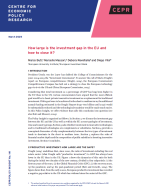Draghi (2024) underlines that, since 2020, the ratio of investment excluding the real estate sector (what Draghi calls “productive investment”) to GDP has always been lower in the EU than in the US. However, the EU is not a homogeneous area. To assess the investment gaps within the EU, Table 1 splits the EU countries into four groups: Continental Europe (Belgium, Germany, France, Luxembourg, the Netherlands, and Austria); Eastern Europe (Bulgaria, Czechia, Hungary, Poland, Estonia, Croatia, Latvia, Lithuania, Slovenia, and Slovakia); the Mediterranean countries (Greece, Spain, Italy, Cyprus, Malta, and Portugal); and the Nordic countries (Denmark, Finland, and Sweden). Table 1 presents the dynamics of different typologies of investment across various subperiods.
Table 1 EU real investment across periods, types of technology and country groups
Source: Authors’ elaboration based on EIB data.
In the years 2009 to 2016, investment ratios in real estate and construction suffered strong negative adjustments in Eastern Europe and the Mediterranean countries following the housing bubble that preceded the Great Financial Crisis. A downsizing occurred also in the Continental and Nordic countries, albeit at a more moderate pace. Investment in real estate recovered moderately since 2016 with the exception of the Nordic countries, where stabilisation had already begun at the end of 2010 and led to a stronger recovery since 2013.
Trends and cyclical changes in investment in traditional technologies were quite aligned across the EU during the first 20 years of the new Millenium with the exception of Eastern Europe, which, due to its catching-up process, has been more reliant on investment in these technologies. It is worth noting that investment ratios in innovative technologies in the Nordic countries were 2½ to 3 percentage points higher than those achieved in Continental Europe, even though the latter did not have a substantially lower per capita income. Unsurprisingly, the gap in innovative investment compared to the Mediterranean countries – and, a fortiori, with Eastern Europe – was even more pronounced
In sum, this evidence shows that, in contrast to the Nordic countries, Continental Europe and the Mediterranean countries seem to be trapped in a ‘curse of mature technology’. From our perspective, however, this evidence offers an additional insight: the gaps in innovative investment within the EU and the relative uniformity characterising traditional investment point to no significant substitution between the two types of investment.
Traditional and innovative investments: Complements or substitutes?
Various commentators (e.g. Gros et al. 2024, Zettelmeyer 2025) suggest that the crucial goal is not an increase in overall investment but its composition. In the view of these scholars, the issue at stake is mainly the substitution of innovative investments for traditional ones. We share the incipit of their view: unless the EU economy embarks on a path of ‘creative destruction’, reducing its reliance on robust but traditional technologies, it will remain stuck in the current ‘mature technology trap’ (Fuest et al. 2024). However, the sequitur of their argument – that ‘creative destruction’ can occur via a shift to innovative technologies that crowd out traditional technologies in the short run – is questionable. As argued above, the comparison between different subsets of investment in the Nordic and in the Continental countries during the last two decades points to higher innovative investment going hand-in-hand with relative uniformity in traditional investment.
Supporters of the substitution approach often refer to the Schumpeterian analysis of the dynamics of economic development triggered by the process of ‘creative destruction’ in market economies (Schumpeter 1912). Referring to Schumpeter’s distinction between traditional firms and innovators, they maintain that the entry of the latter immediately put the former out of the market. However, this reading of Schumpeter is ill-founded (Messori 2004).
Processes of ‘creative destruction’ require new actors carrying out innovative and risky investments that are added to traditional ones. Innovative investments can succeed or fail over time. In the meantime, market signals play against the substitution of investments with uncertain outcomes for investments in more traditional activities, because these latter activities continue to be profitable. Therefore, there will be replacement only when innovative activities are eventually validated by the market and thus become more profitable than the previous average. At this moment, traditional activities suffer losses and are pushed out of the market.
According to the Schumpeterian scheme, in the short to medium term, there is complementarity rather than substitution between traditional and innovative activities. This result depends on the specific features – such as the assumptions of a lengthening of the innovative production process and full employment – of Schumpeter’s model. However, these traits mirror typical aspects of international value chains and the shortage of human resources with qualifications to match innovations. Read with this perspective, Schumpeter's analysis seems to capture well the case of the European automotive supply chain.
Capital markets integration and targeted policy support matter
To redirect production activities towards high-tech sectors, it is necessary to activate processes that take time. These processes can be speeded up by well-integrated financial markets and an appropriate composition of public spending.
European financial markets are largely bank-based. Moreover, institutional intermediaries (pension funds and the life branches of insurance companies) tend to be small and have limited appetite for equity and risk. Even the limited share of their resources allocated in equity are thus invested either in global portfolios or in a small set of domestic companies, but rarely cross-border within the EU.
This does not lend itself to a swift reallocation of resources towards innovative technologies that are typically characterised by high risk and high return and tend to be backed by weak collateral. Therefore, their financing requires funding via capital markets (shares) or via non-market forms of equity (such as private equity or venture capital). The underdevelopment of these financial instruments in many EU countries contributes to keep innovative investment low.
The exception, at least in relative terms, is represented by the Nordic countries and the Netherlands. Although less advanced than the US, the Nordic countries have deeper financial markets. It does not come as a surprise, therefore, that equity finance for innovation plays a more important role in these countries than in the rest of the EU. As shown in Figure 1, there is a positive correlation between the degree of integration and the depth of financial markets, on the one hand, and innovative investment on the other hand.
Figure 1 Innovative investment versus the structure of financial markets in EU countries
Source: Authors’ elaboration based on EIB data.
A stronger appetite for equity would potentially bring upsides for EU wealth owners as well as for EU firms. EIB (2025) shows that households could secure higher long-term returns on their financial portfolios. Also, firms could utilise larger capital availability to improve their growth rates: firms issuing equity as a source of financing are 7 percentage points more likely to invest and 12 percentage points more likely to innovate.
Public spending also affects the quantity and quality of investment. Most governments in the EU support private sector investment via public subsidies. A survey of EU firms conducted by the EIB (2025) shows that 16% of these firms received financial support in 2024. What is striking is the different allocation of such policy support in the different groups of EU countries. As illustrated by Figure 2, there is a positive correlation between the concentration of national public interventions in support of innovative firms and investment in high-tech sectors. Unlike the rest of the EU, the Nordic countries are characterised by a more focused allocation of public subsidies in support of firms operating in high-tech sectors.
Figure 2 Share of firms receiving grants in the high-tech sector and other sectors
Source: Authors’ elaboration based on EIB data.
In sum, the functioning of financial markets and the targeting of public expenditure support are important in easing the EU’s financing constraints, and hence in accelerating the deployment of innovative investment. These results can be achieved via deeper and more integrated EU capital markets (Capital Markets Union, lately dubbed Saving and Investment Union) and an intelligent application of the EU fiscal rules. These policy reforms need to be embedded in a policy strategy based on the production of European public goods in the green, digital, and social transitions, as well as in defence and security. In this regard, the forthcoming reform of the European budget is key, as is the role of the European Investment Bank.
References
Buti, M, M Messori, D Revoltella and D Vila (2025), “How large is the investment gap in the EU and how to close it?”, CEPR Policy Insight 141.
Draghi, M (2024), Report on EU Competitiveness, European Commission.
EIB – European Investment Bank (2025), Innovation, integration and simplification in Europe, EIB Investment Report 2024/2025.
European Commission (2025), A Competitiveness Compass for the EU.
Fuest, C, D Gros, P-L Mengel, G Presidente and J Tirole (2024), EU Innovation Policy. How to Escape the Middle Technology Trap, Report by the European Policy Analysis Group, Econpol&Cesifo, IEP&BU and Toulouse School of Economics.
Gros, D, P-L Mengel and G Presidente (2024), “What investment gap? Quality instead of quantity”, IEP&BU Policy Brief No. 21.
Messori, M (2004), “Credit and money in Schumpeter’s theory”, in R Arena and N Salvadori (eds), Money, credit and the role of the state, Ashgate, pp. 175-200.
Schumpeter, J A (1912), Theorie der wirtschaftlichen Entwicklung, 2nd ed., Duncker & Humblot, 1926 (published in English as The theory of Economic Development, Oxford University Press, 1934).
Zettelmeyer, J (2025), “Draghi on a shoestring: the European Commission’s Competitiveness Compass”, Bruegel Analysis, 3 February.













